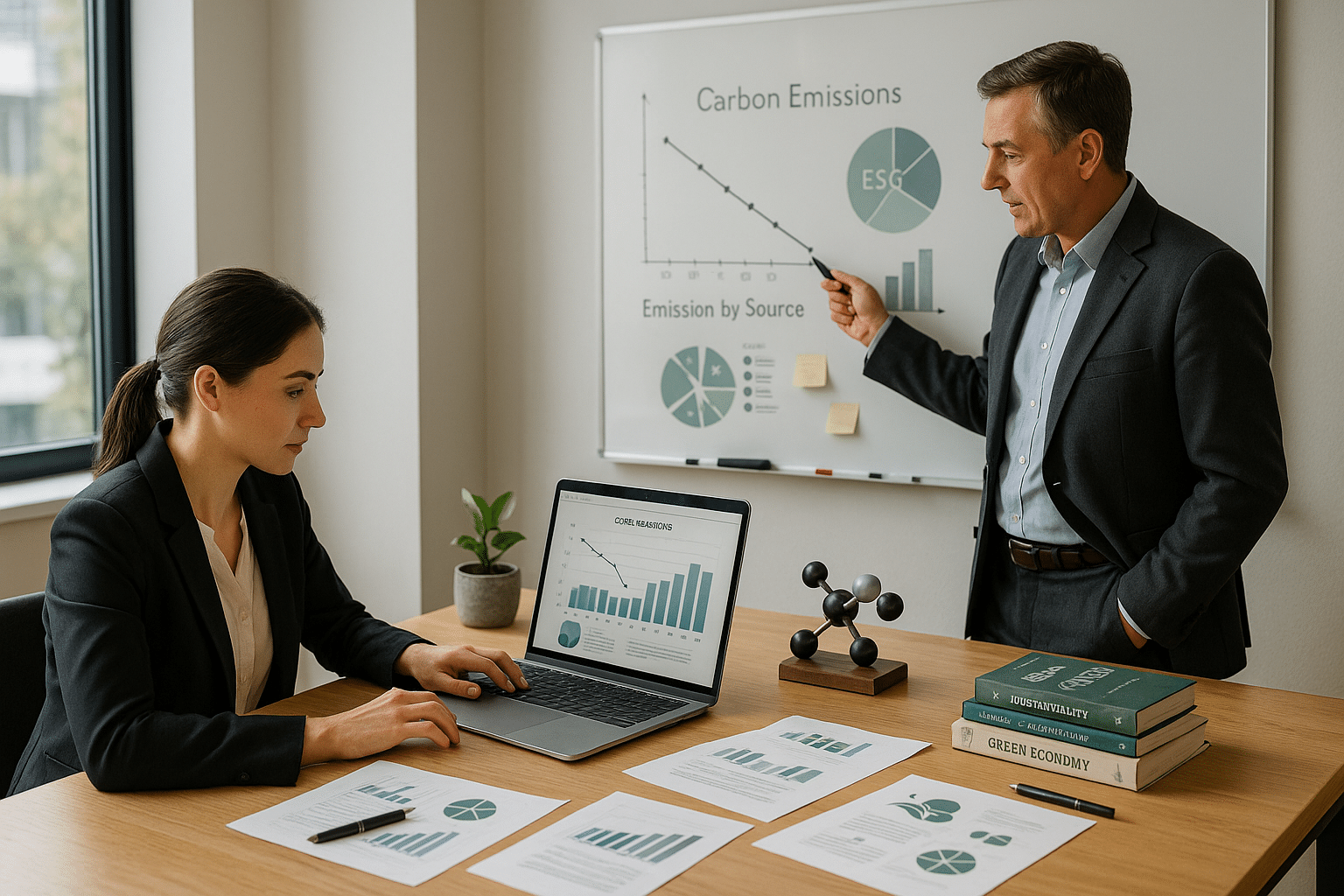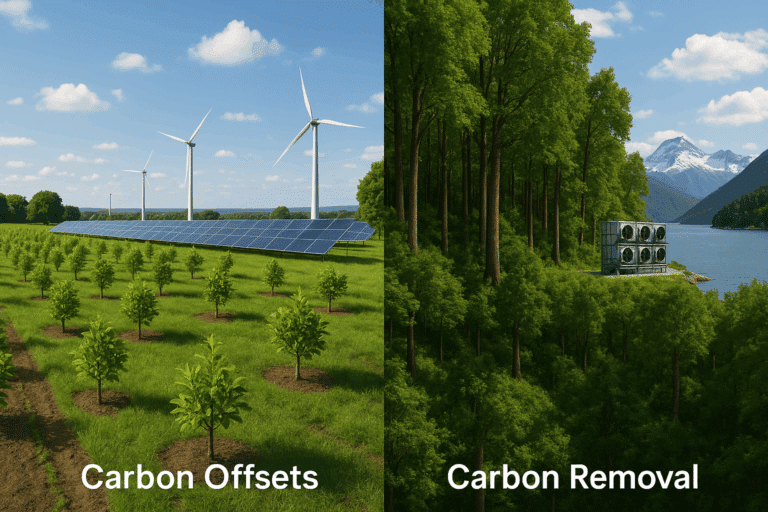With the world’s increasing focus on sustainability, understanding the carbon footprint of an organization is becoming crucial.🌎 This guide provides a detailed look at the power of carbon, illuminating its significance within ESG strategies.
Why is carbon so important, you might ask? Its impact on our environment is colossal, and therefore, managing and reporting it plays a fundamental role in ESG strategies. In this blog, we will dive deep into carbon reporting, deciphering what it is, why it matters, and how it is incorporated into ESG frameworks.⚙️
Don’t worry; we will be simplifying these seemingly intricate concepts for you. Before you know it, you’ll be well-versed in carbon reporting, understanding its crucial role in defining a company’s sustainability and reputation.
Strap in, and let’s embark on a journey into the world of carbon and its unparalleled influence in ESG strategies.🚀
Setting the Scene: The Importance of Carbon Reporting
First, we will tackle the significance of carbon reporting. Carbon dioxide and other greenhouse gases are notorious for their role in global warming. Hence, the ability to measure, manage, and report these emissions is becoming a primary concern for organizations across the globe.
But what does carbon reporting entail? Essentially, it involves quantifying the amount of carbon dioxide and other greenhouse gases a company produces during its operations. This information is vital as it helps businesses identify areas where they can reduce emissions, contributing to global efforts to combat climate change.🌿
Zooming in: The Intricacies of Carbon Reporting
Next, we will delve into the intricacies of carbon reporting. We will discuss the different methodologies and standards, such as the Greenhouse Gas Protocol, that guide companies in their reporting efforts. Understanding these standards is key to developing a reliable and comprehensive carbon reporting strategy.⚖️
Moreover, we will explore the different types of emissions – Scope 1, Scope 2, and Scope 3 – and how they fit into the carbon reporting framework. Each type has its unique characteristics and reporting requirements, and understanding these nuances is fundamental to effective carbon management.
Connecting the Dots: Carbon Reporting and ESG Strategies
Finally, we will delve into the connection between carbon reporting and ESG strategies. Carbon management is not just about reducing emissions for the sake of the environment. It also has profound implications for a company’s social responsibility and governance.⚖️
In other words, effective carbon reporting can enhance a company’s ESG performance, leading to increased investor confidence, improved brand reputation, and a healthier bottom line. But how does this work exactly? Stay tuned, and we’ll unveil the power of carbon in driving ESG strategies.
So, are you ready to uncover the complexities and possibilities that carbon reporting offers in the world of ESG?🔍🌱Let’s dive in!
Understanding the Core of Carbon Reporting
The world of sustainability reporting is vast and often complex, but one of the key components that is increasingly gaining attention is carbon reporting. This method of reporting is focused on identifying, measuring, and communicating an organization’s carbon emissions. As environmental, social, and governance (ESG) strategies become more integrated into the fabric of businesses, understanding and harnessing the power of carbon reporting is crucial. So, let’s start with the basics.
Carbon reporting essentially involves the process of disclosing data about an organization’s greenhouse gas (GHG) emissions. This data is often measured in carbon dioxide equivalents (CO2e), which allows different types of GHGs to be compared based on their potential to contribute to global warming. Here’s a quick video by the Carbon Trust that explains how carbon reporting works. (Title: How does carbon reporting work? | Carbon Trust).
The information gleaned from carbon reporting can be instrumental in helping companies understand their environmental impact, make informed decisions about their operations, and communicate their commitment to sustainability to stakeholders. But more than just a tool for corporate responsibility, carbon reporting can also be a driver for innovation and competitiveness, as companies explore ways to reduce their carbon footprint while maintaining or even increasing their productivity.
Decoding the Benefits of Carbon Reporting
Before diving into the mechanics of carbon reporting, it’s essential to comprehend the benefits it brings to the table. Although carbon reporting may seem like an additional burden, the advantages it provides far outweigh the initial investment in terms of time and resources.
Firstly, carbon reporting is a potent tool for risk management. Climate-related risks are becoming a significant concern for businesses, and they can take many forms, including physical risks (like extreme weather events) and transition risks (like changes in climate policies or market preferences). By quantifying and disclosing their carbon emissions, companies can identify and manage these risks more effectively. For instance, a company might find that a significant portion of its emissions comes from a particular source, such as its supply chain, which could then be targeted for reductions to mitigate risk.
Secondly, carbon reporting can lead to cost savings. By identifying areas of high emissions, companies can seek ways to improve their efficiency and reduce their carbon footprint, which often results in lower operating costs. This aligns with the concept of “eco-efficiency,” where environmental improvements coincide with economic benefits.
Carbon Reporting in ESG Strategies
As we dig deeper into the realm of carbon reporting, it’s essential to understand its place within broader ESG strategies. ESG refers to the three central factors in measuring the sustainability and ethical impact of an investment in a company or business. Carbon reporting, especially when it’s aligned with international standards like the Greenhouse Gas Protocol, can provide valuable data for the “E” or environmental component of ESG reporting.
The integration of carbon reporting in ESG strategies signifies a company’s commitment to transparency and sustainability. More and more investors are looking at ESG factors to guide their investment decisions, and carbon reporting provides them with concrete data on a company’s environmental impact. Companies that report on their carbon emissions are also more likely to be proactive in reducing their emissions, which can contribute to a positive ESG rating.
But carbon reporting is not just about attracting investors. It also enables companies to engage with other stakeholders, including employees, customers, and the wider community. By demonstrating their environmental responsibility through carbon reporting, companies can enhance their reputation, motivate their workforce, and strengthen their brand.
Comparison of Carbon Reporting Standards
When it comes to carbon reporting, there are several standards that companies can choose to follow. While all of these standards aim to guide companies in measuring and reporting their GHG emissions, they differ in their scope and focus. The table below provides a comparison of three widely used carbon reporting standards: the Greenhouse Gas Protocol (GHG Protocol), the Global Reporting Initiative (GRI Standards), and the Climate Disclosure Standards Board (CDSB Framework).
| Standard | Focus | Scope |
| GHG Protocol | Comprehensive global standard for measuring and managing GHG emissions. | Covers direct and indirect emissions from all sectors. |
| GRI Standards | Internationally recognized standards for sustainability reporting. | Covers a wide range of sustainability issues, including GHG emissions. |
| CDSB Framework | Framework for companies to disclose environmental information in their mainstream reports. | Covers seven environmental categories, including GHG emissions. |
Understanding the differences between these standards can help companies choose the most suitable one for their needs. For a more detailed explanation of these standards, I recommend watching this video by ACCA (Title: ESG: Global standards on sustainability reporting | ACCA).
The Future of Carbon Reporting
While carbon reporting is already a significant part of many companies’ ESG strategies, its importance is set to grow even further in the coming years. As the world grapples with the effects of climate change, there is an increasing demand for companies to be more transparent about their environmental impact. This, in turn, will lead to more stringent regulations and higher expectations from stakeholders.
One of the key trends in the future of carbon reporting is the move towards mandatory disclosure. While many companies currently report their carbon emissions voluntarily, there is a growing push for mandatory reporting, particularly for large corporations. This would help to ensure that all companies are held to the same standards and that investors have access to consistent and comparable data.
Another trend is the rise of “net zero” commitments. More and more companies are pledging to achieve net zero emissions by a certain date, which means that they aim to balance the amount of GHG they emit with the amount they remove from the atmosphere. Carbon reporting will play a critical role in tracking progress towards these goals and holding companies accountable.
Demystifying Carbon Reporting: A Step towards Sustainability
To conclude, carbon reporting is more than just a tick-box exercise; it’s a tool for companies to understand their environmental impact, manage risks, save costs, and engage with stakeholders. By integrating carbon reporting into their ESG strategies, companies can drive innovation, enhance their reputation, and contribute to a more sustainable world.
The future of carbon reporting is likely to be marked by greater transparency, stricter regulations, and more ambitious targets. But regardless of these changes, the fundamental purpose of carbon reporting will remain the same: to help companies transform their operations for a low-carbon economy and a sustainable future.
Whether you’re just starting out with carbon reporting or looking to improve your existing processes, I hope this guide has provided you with some useful insights. As you embark on your carbon reporting journey, remember that every step you take towards sustainability is a step in the right direction.

Conclusion
In this extensive guide, we’ve covered a wide array of topics, from the rudimentary principles of software engineering, the intricacies of computer programming languages, to the multifaceted aspects of Information Technology (IT) industry. While these topics are indeed vast and complex, my aim was to break down these notions into digestible, understandable segments. And I hope that this objective has been successfully achieved.
Let’s briefly revisit some of the key points we’ve discussed. We started by delving into the fundamental concepts of software engineering, acknowledging its pivotal role in today’s digital world. We then moved on to understanding different programming languages, their use-cases, and their impact on the IT industry. Subsequently, we unpacked some of the complex aspects of the IT industry and how they’re changing the landscape of our modern world.
It’s important to note that each of these topics is multifaceted and requires a dedicated focus to truly grasp its depth. However, this guide was intended to provide an overarching understanding, hopefully paving the way for further exploration and study. The intricacies of the IT industry and software engineering are endless and understanding them can open up an array of opportunities.
I encourage you to revisit this guide, delve deeper into the areas that have piqued your interest, and don’t hesitate to share this article within your network. By doing so, you’re not only helping spread knowledge but also nurturing a culture of shared learning and growth. And remember, in the realm of technology and IT, continuous learning is not just an option, it’s a necessity.
I’d love to hear your thoughts, ideas, or questions on the matter. Feel free to comment below. 👇 Your feedback and engagement are what keeps this platform a dynamic and interactive space for learning.
So, keep exploring, keep learning, and keep sharing. You can start your further research by checking the list of valuable resources I’ve prepared for you at the end of the article. You can also share this article on your favorite social media platform using the share buttons below. 📲
Remember, the journey of learning is a marathon, not a sprint. Embrace the process and enjoy the ride! 🚀
References:
Remember, always credit your sources and cite responsibly. 📚
Thank you for reading, and until next time, keep exploring the digital world! 🌐



